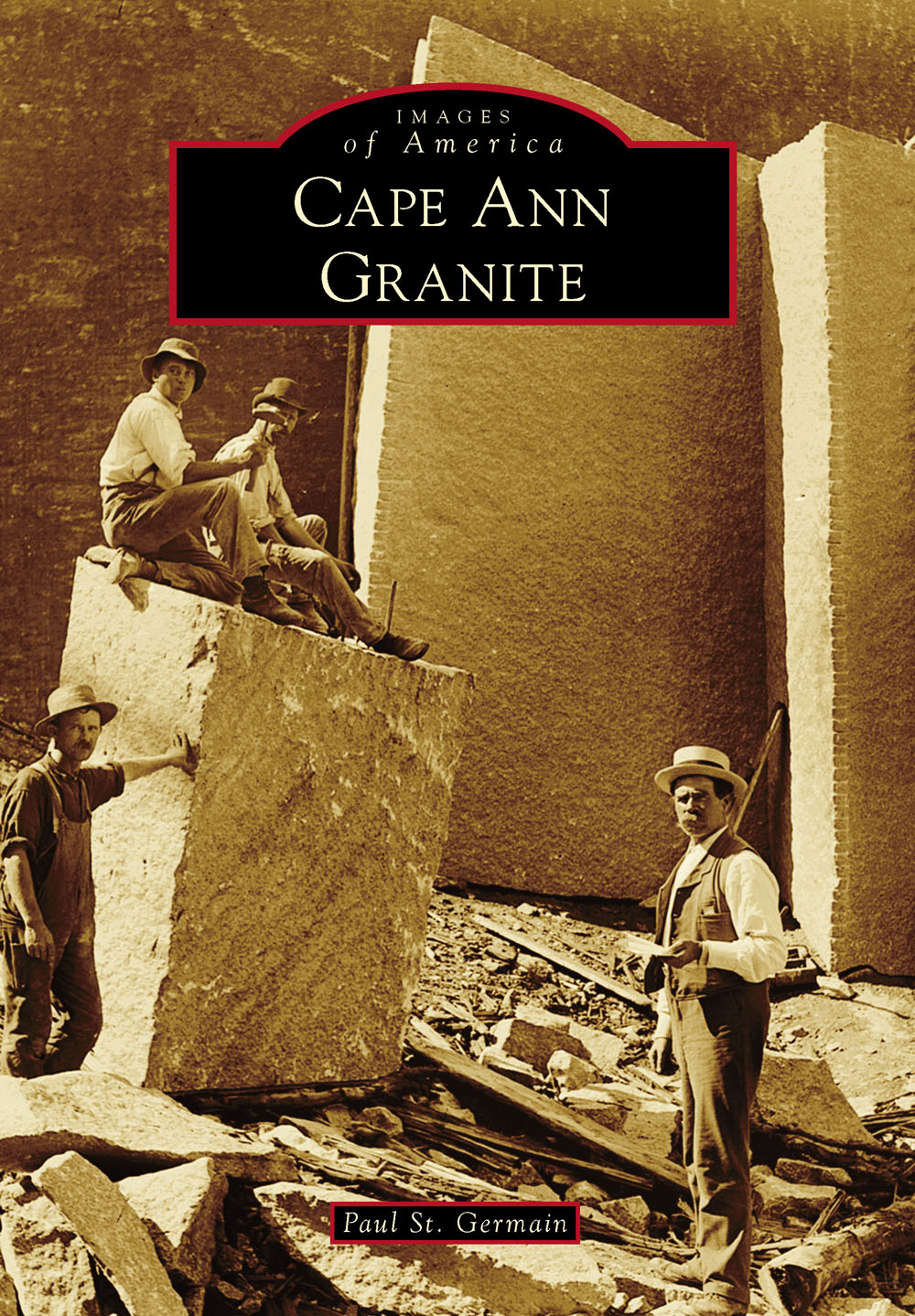St. Germain - Cape Ann Granite
Here you can read online St. Germain - Cape Ann Granite full text of the book (entire story) in english for free. Download pdf and epub, get meaning, cover and reviews about this ebook. City: Ann;Cape (Mass.);Essex County (Mass.);Massachusetts;Cape Ann;Essex County, year: 2015, publisher: Arcadia Publishing Inc., genre: Home and family. Description of the work, (preface) as well as reviews are available. Best literature library LitArk.com created for fans of good reading and offers a wide selection of genres:
Romance novel
Science fiction
Adventure
Detective
Science
History
Home and family
Prose
Art
Politics
Computer
Non-fiction
Religion
Business
Children
Humor
Choose a favorite category and find really read worthwhile books. Enjoy immersion in the world of imagination, feel the emotions of the characters or learn something new for yourself, make an fascinating discovery.

- Book:Cape Ann Granite
- Author:
- Publisher:Arcadia Publishing Inc.
- Genre:
- Year:2015
- City:Ann;Cape (Mass.);Essex County (Mass.);Massachusetts;Cape Ann;Essex County
- Rating:3 / 5
- Favourites:Add to favourites
- Your mark:
- 60
- 1
- 2
- 3
- 4
- 5
Cape Ann Granite: summary, description and annotation
We offer to read an annotation, description, summary or preface (depends on what the author of the book "Cape Ann Granite" wrote himself). If you haven't found the necessary information about the book — write in the comments, we will try to find it.
Cape Ann Granite — read online for free the complete book (whole text) full work
Below is the text of the book, divided by pages. System saving the place of the last page read, allows you to conveniently read the book "Cape Ann Granite" online for free, without having to search again every time where you left off. Put a bookmark, and you can go to the page where you finished reading at any time.
Font size:
Interval:
Bookmark:

IMAGES
of America
CAPE ANN
GRANITE

Although there were over 60 quarries and motions across Cape Ann from the 1830s to the 1950s, this map represents only the major quarries and quarrying areas that are noted in this book. (Authors collection.)
ON THE COVER: William R. Cheves, owner of the Cheves Green Granite Company, is holding a work order for his men. This is his Devils Rock Quarry in Lanesville, which was sometimes known as Deep Pit and now Hancock Quarry, named after the famous sculptor Walker Hancock, who bought the property in the early 1930s. Cheves owned eight acres of land and two other quarries, Cheves and Cheves Reservoir Quarry, which were worked until 1917. (Courtesy of the Cape Ann Museum.)
IMAGES
of America
CAPE ANN
GRANITE
Paul St. Germain

Copyright 2015 by Paul St. Germain
ISBN 978-1-4671-2363-1
Ebook ISBN 9781439652435
Published by Arcadia Publishing
Charleston, South Carolina
Library of Congress Control Number: 2014958700
For all general information, please contact Arcadia Publishing:
Telephone 843-853-2070
Fax 843-853-0044
E-mail
For customer service and orders:
Toll-Free 1-888-313-2665
Visit us on the Internet at www.arcadiapublishing.com
To my grandchildren, Taylor, Olivia, Hunter, Luke, Nathaniel, Shane, and Vivienne, who are the foundation blocks of our family, may you all build wonderful lives.
CONTENTS
ACKNOWLEDGMENTS
I would like to extend my gratitude to the following individuals who gave generously of their time, shared their knowledge of granite and its story, provided their expertise in working with vintage photographs, and dispersed their wisdom. All of this support enhanced my research and understanding of the history of granite on Cape Ann.
Martha Oaks, curator of the Cape Ann Museum, encouraged me to write this book to complement the museums excellent granite exhibit. This was prompted by the fact that the definitive book on Cape Ann granite by Barbara Erkkila, Hammers On Stone, is long out of print. I thank her also for allowing me to use some of her words in a portion of my introduction.
My thanks to Barbara Erkkila, Cape Ann granite expert, who I spoke to many times before her death in 2013. She was always eager to answer my many questions with generosity, grace, and humor. I will miss her.
Stephanie Buck, Cape Ann Museum librarian, guided me to the many files on Cape Ann and the Barbara Erkkila Collection.
Fred Buck, Cape Ann Museum photograph archivist and digital magician, repaired and digitized hundreds of photographs from 1830 to 1930, many from Barbaras collection.
Gwen Stephenson, curator of the Sandy Bay Historical Society, gave me access to the archives of the Rockport and Cape Ann Granite Companies, which dated back to the 1830s, providing me with a wealth of records, images, and correspondence.
Les Bartlett, Cape Ann historian and Granite Museum consultant, shared his extensive knowledge of the Rockport Granite Company and the quarry workers of the mid-19th century. Les assisted in the development of the granite exhibits at both the Cape Ann Museum and the Sandy Bay Historical Society Museum.
Lois Brynes, natural historian, actually lives near several quarries in Pigeon Cove. Lois taught me how granite got here and what it is and what it is not. Also, she tipped me to information sources I would never have found on my own.
Thanks to Caitrin Cunningham, my patient editor at Arcadia, who reviewed hundreds of photographs and selected the best quality possible for this book.
Most of the images appear courtesy of the Cape Ann Museum (CAM) and the Sandy Bay Historical Society (SBHS); all others are as noted.
INTRODUCTION
Granite is the land itself and has waited for the ingenuity and vision of man to give it beauty and meaning.
The Building Stone Institute of America Pledge
The history of Cape Ann granite started 400 million years ago when the bedrock batholithic granite cooled deep under a volcanic micro-continent known among geologists as Avalonia. Avalonia is the name given by modern geologists to the first land forming the ground beneath our feet here on Cape Ann. A deep-seated igneous rock called granite makes up most of the bedrock of Cape Ann. Igneous rock (Greek ingis, meaning fire) is formed by the cooling and crystallization of molten rock material called magma when deep underground. The harvesting of granite from quarries dug deep in the earth was big business here on Cape Ann from the 1830s through the early 20th century. Second only to fishing in economic output, for 100 years the granite trade played a pivotal role in the local economy, providing jobs for many, turning profits for some, and generating tons and tons of cut granite that was used here on Cape Ann and shipped to ports all along the Atlantic Seaboard and eventually across the nation.
Granite quarrying started slowly in the area in the late 18th century, with small operators peppered across rocky terrain. Construction of a fort at Castle Island in Boston Harbor in 1798 followed by a jail in nearby Salem in 1813 jump-started the local granite business. During the 1830s and 1840s, the trade grew steadily. By the 1850s, the stone business was firmly established, and Cape Ann granite was known throughout the region. So extensive and so awe inspiring were operations during the second half of the 19th century that some observers feared that the business might actually run out of stone.
While granite was taken from the earth in all different sizes and shapes, Cape Ann specialized in the conversion of that granite into paving blocks, which were used to finish roads and streets. Millions of paving stones were shipped out of Cape Ann annually, destined for construction projects in New York, Philadelphia, Pennsylvania, New Orleans, Louisiana, and San Francisco, California. The cutting of paving stones kept Gloucester and Rockport workers busy throughout the year but particularly during the winter months. (It was said that granite was more difficult to wrestle out of the earth during winter, hence the cutting of paving blocks out of larger pieces of stone was something that kept men employed during the cold months.) Come summer, large shipments of blocks would be packed aboard specially designed sloops and transported to distant ports.
The quarries of Cape Ann were numerous; at least 60 were worked from the mid-1800s until 1930, when the Rockport Granite Company went out of business. This book is organized to take readers on a tour of the major quarries around Cape Ann, starting on the western shore in the Bay View section of Annisquam and Hodgkins Cove. Next, we move on to Lanesville, Lanes Cove, Folly Cove, around to the northern end of the cape past Halibut Points Babson Farms Quarry heading south down to Pigeon Cove, and finally to Rockport, the home of the Rockport Granite Company, which had purchased most of the quarries and granite companies by 1915.
The granite companies consisted of two-man motions as well as large ones employing from 800 to 1,200 workers over the years. A motion was a small quarry that usually was operated by two men who cut paving stones to sell themselves or to the big quarry companies. The majority of workers were immigrants who came from Ireland, Finland, Sweden, Scotland, and Italy. The major companies included the Rockport Granite Company (18641931), Cape Ann Granite Company (18691892) out of Bay View, Cheves Green Granite Company (18761917), Lanesville Granite Company (18551909), Pigeon Hill Granite Company (18701914), and Bay State Granite Company (18741879). All the companies had limited life spans, some began as early as 1848, and few lasted until 1948, when the last company, the Ultimate Paving Block Company (19301948), finally went under.
Next pageFont size:
Interval:
Bookmark:
Similar books «Cape Ann Granite»
Look at similar books to Cape Ann Granite. We have selected literature similar in name and meaning in the hope of providing readers with more options to find new, interesting, not yet read works.
Discussion, reviews of the book Cape Ann Granite and just readers' own opinions. Leave your comments, write what you think about the work, its meaning or the main characters. Specify what exactly you liked and what you didn't like, and why you think so.








